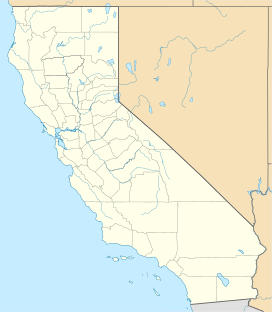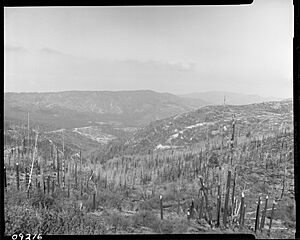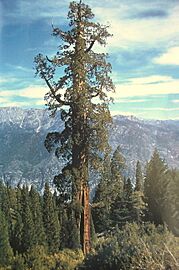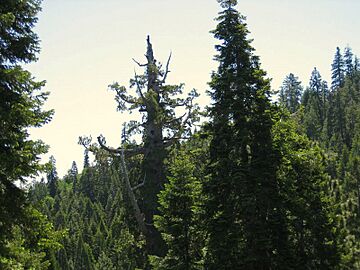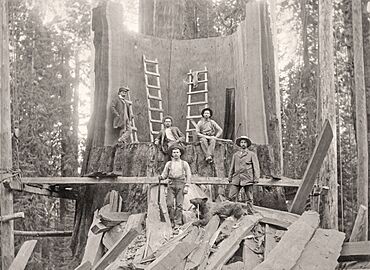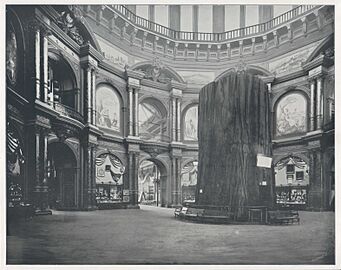Converse Basin Grove facts for kids
Quick facts for kids Converse Basin Grove |
|
|---|---|

A steam donkey crew at the Boole Tree, 1894.
|
|
| Map | |
| Geography | |
| Location | Fresno County, California, United States |
| Coordinates | 36°48′00″N 118°58′00″W / 36.8°N 118.966667°W |
| Elevation | 5,900–6,600 ft (1,800–2,000 m) |
| Area | 4,666 acres (18.88 km2) |
| Ecology | |
| Dominant tree species | Sequoiadendron giganteum |
The Converse Basin Grove is a special place filled with giant sequoia trees. You can find it in the Giant Sequoia National Monument in California. It's about 5 miles (8 km) north of General Grant Grove.
This grove was once home to the largest group of giant sequoias in the world. It covered a huge area of 4,600 acres (18.6 km²). But around the year 1900, a company called Sanger Lumber Company cut down most of these amazing trees. They used a method called clearcutting, which means cutting down almost all the trees in an area. About 8,000 giant sequoias were cut, many of them over 2,000 years old. This destroyed the old forest environment.
Even after many years, Converse Basin Grove has not fully recovered. People tried to help it grow back by planting new trees and stopping forest fires. However, these efforts caused new problems. Two big wildfires have happened since the logging stopped. Despite these challenges, the grove is a great place to study how forests can heal and how we can help them.
Converse Basin Grove is still home to some famous giant sequoia trees. These include the Boole Tree, which is the sixth largest of its kind. Another famous spot is the Chicago Stump. This is what's left of the General Noble Tree, which was cut down for a big fair in 1893. The Muir Snag is also here. It's a very old dead tree, believed to have been 3,500 years old when it died.
Contents
History of Converse Basin Grove
How the Grove Got Its Name
Converse Basin was named after Charles P. Converse. He was one of the people who started the Kings River Lumber Company. In the 1860s, he planned to cut down trees in this area. But money problems stopped his plans, and he soon left the company.
The Logging Era
Converse Basin was once the second-largest giant sequoia grove on Earth. But between 1892 and 1918, most of its giant sequoias were cut down. The Kings River Lumber Company, later called Sanger Lumber Company, started logging here. They used a very destructive method called clearcutting. In just ten years, they cut down 8,000 giant sequoias. Only about 60 to 100 large trees survived.
Efforts to Protect the Trees
In the 1870s, people who cared about nature, called conservationists, started to worry about the trees. Colonel George W. Stewart, a newspaper publisher, helped connect local efforts to save the sequoias with a bigger national movement. Because of these efforts, Sequoia National Park, General Grant Grove, and Yosemite National Park were created in 1890.
Sadly, federal protection came too late for most of Converse Basin Grove. The area was not officially protected from logging until April 2000. That's when President Bill Clinton made it part of the Giant Sequoia National Monument.
Impact on the Environment
Cutting down so many giant sequoias in Converse Basin ruined the old-growth forest ecosystem. This special environment is needed for the trees to survive. In 1915, a writer named Henry Seidel Canby wrote about the destruction. He described the area as a "vast and lonely cemetery" with broken tree trunks and torn roots. He noted that the forest was gone, and the soil was damaged.
In the 1930s, park officials Walter Fry and John R. White were amazed at how much damage humans had done with simple tools.
Managing the Forest Today
Converse Basin has not recovered even after more than a century since the logging stopped. People tried to restore the forest by planting only one type of tree, called conifer plantations. But these new trees have not grown well. They are easily attacked by pine beetles. They have also changed how water moves through the area, leading to more dead trees. This creates a lot of dry wood, which can easily catch fire.
Wildfires in the Grove
Two big wildfires have happened in Converse Basin since logging ended in 1918. The first was the McGee Fire in 1955. It burned all the young sequoias and almost reached the Boole Tree. This fire helped people realize that stopping all fires can be dangerous. It showed the benefits of controlled burns, called prescribed burns. The second fire was the Rough Fire in 2015. It burned some of the same area as the McGee Fire. Luckily, no very large or historic trees were harmed.
Exploring Converse Basin Grove
There are three main trails in Converse Grove for visitors to enjoy:
- The Boole Tree Trail is a moderate 2.5-mile (4 km) loop. It has restrooms but no drinking water. You can see great views of the Kings River gorge and the Sierra Nevada mountains. The trail goes through forests of fir, oak, cedar, and some young sequoias.
- The Chicago Stump Trail is an easy 0.5-mile (0.8 km) loop. It winds through a meadow with young sequoias. It leads to the remains of the famous Chicago Stump.
- Stump Meadow is a meadow full of sequoia stumps left from the old logging days. It's surrounded by young sequoias that are about 100 years old. Scientists are studying why this area hasn't grown back like other parts of the grove.
Famous Trees in the Grove
Some of the most amazing trees in Converse Basin Grove include:
- Boole Tree: For a while, some people thought the Boole Tree was the biggest tree in the world. After careful measurements, it was found to be the 6th largest. It has a huge base, over 112 feet (34 m) around, and stands 267 feet (81 m) tall. It is the largest giant sequoia found on National Forest System lands.
- Chicago Stump: This is what's left of the General Noble Tree. This tree was cut down for a big fair called the World's Columbian Exposition in 1893. The General Noble Tree was the second-largest tree in the grove before it was cut. It was likely one of the top 30 largest giant sequoias ever.
- Muir Snag: The Muir Snag is one of the biggest and tallest standing dead trees in the world. It is thought to have been over 3,200 years old when it died. Its base was about 35.9 feet (10.9 m) across. The tree is still standing, but it's only about 140 feet (43 m) tall now. It's named after the famous naturalist John Muir. He described it as "the largest I measured" in a report.
Gallery
-
Boole, the 6th largest giant sequoia in the world.
See also
- List of giant sequoia groves
- Hume-Bennett Lumber Company
- Nelder Grove - another giant sequoia grove that was logged a lot in the past.


